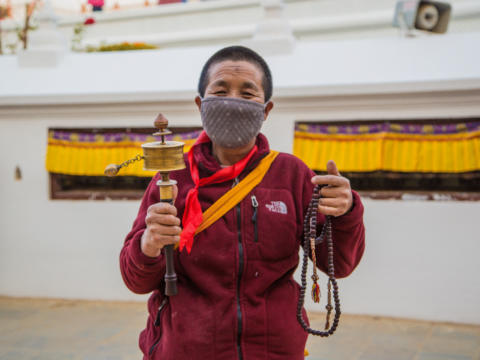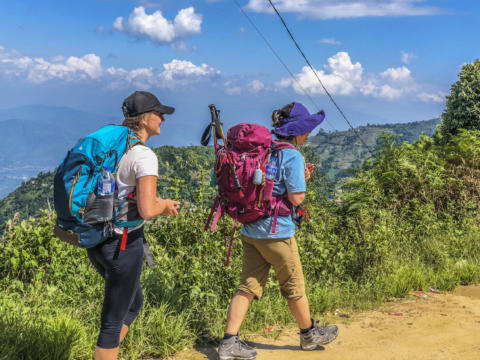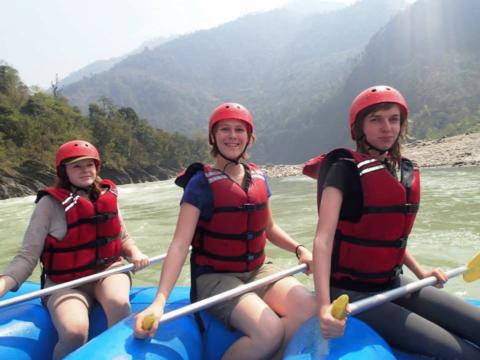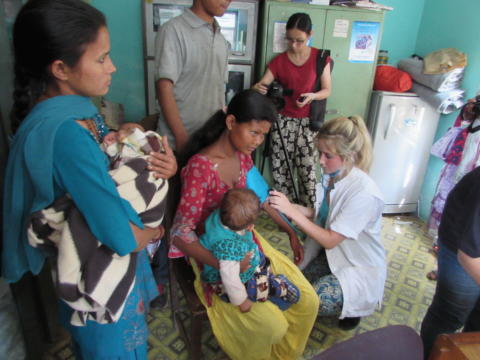Only 600€ per week!
Village Trek
Central Nepal - Nepal
Experience the Himalayas and the culture and lifestyle of its inhabitants like very few get to do!
During this week of trekking, we will be walking through different villages in order to experience the culture and lifestyle of locals. We will stay in authentic houses and try out the local cuisine to get a chance to immerse fully into the lives of the Nepali.
Program Description
This program will give you the opportunity to experience the mountains and cultures that very few outsiders get to see. During this trek, you will be walking through different villages, eating the region’s food and staying at local houses. This program will give you a very different experience than a regular trek will! If you are more interested in experiencing Nepali culture up close, then this village trek is for you!
The routes are designed to pass through a number of small villages that rarely (if ever!) get visited by tourists. You will meander among rice fields, stay will locals, eat authentic food and get to observe the village life up-close. Moreover, we will meet farmers, visit local schools and oh, right! – trek up and down at times too! After all, this is Nepal!
Trip Highlights
Exploring the typical way of life of villages in Nepal, encounter different varied cultures in the Himalayas region with dramatic views of the snow capped mountains.
What is included in the program
- Airport transfers as per the policy – Airport Pickup in Kathmandu – Tribhuvan International Airport
- Presence of a dedicated program coordinator throughout your travel, at the projects and facilities- Logistical management support in case of emergencies
- Authentic Nepali meals and European (breakfast, lunch, dinner) for the duration of the entire program as per the meal plan
- Accommodation at hotels, tea houses, and at our accommodation facility – Shared accommodation
- Local transportation to all venues
- Entry fees to all places
- Extensive pre departure information
- Overland public local transportation
What is excluded in the program
- Personal expenses such as table drinks, room service items, laundry, telephone calls, tips, portage at hotels or airport, bottles of water during your road travel etc.
- Any additional expenses caused by or liability for disturbance in the program due to circumstances, weather conditions, sickness, natural disasters, riots etc.
- Liability for or insurance against injury, loss of life, accidents or loss of goods.
- Our program does not cover any liability and does not insure participants. Participants must have appropriate insurance before joining the program.
- Any camera fee where applicable.
- Any service not specified above.
Few things to consider when you are with us!
- Returning to the accommodation after your personal trips before 22.00 everyday
- You will not be allowed to hire any vehicle on your own
- Consumption of alcohol inside the accommodation is strictly prohibited
- Respect and adhere to our code of conduct
- Our staff is there to support you, guide you and make your trip memorable. We kindly request you to follow their instructions at all times
- You will not be allowed to bring outsiders inside our centers/ guest houses or hotels
Aims & Objectives
The aim of this program is to show you to the authentic Nepal. This trek brings you closer to nature and truly immerse you in the Nepali culture, customs and lifestyle.
Schedule
Monday
Drive to Sankhu for an hour, which is one of the oldest Newari settlements. We will have lunch in Sankhu and then walk for 3 hours to Kartike / Nagarkot (one of the best places to see the Himalayas if the weather is clear). Nagarkot thrills visitors with its unrestricted view of the mountain range from Annapurna in the west to the mighty Everest in the East. Overnight with local family.
Tuesday
Trek to Dhulikhel for about 5 hours. Dhulikhel is one of the old Newari settlements though Nala and one of the most popular places to observe the Himalayas. From the edge of the ridge, a stunning panorama of peaks unfolds, from Langtang Lirung in the east, through Dorje Lakpa to the huge bulk of Gauri Shankar and nearby Melungtse (7181m) and as far as Numbur (5945m) in the east. Overnight with local family.
Wednesday
Trek to Dapcha via Namobuddha for 5 hours. Namobuddha is one of the most sacred Buddhist pilgrimage sites in Nepal. Overnight stay in Dapcha with a local family.
Thursday
Trek to Mate for about 6 hours through Ambode. Mate is a typical Tamang Village. You get to see and experience the life of Tamang in this village. Overnight stay in Mate with a local family.
Friday
Trek to Sipali for about 4 hours and drive to Kathmandu via Banepa. Overnight stay in Kathmandu.
Note: This schedule can be changed and/or amended depending on weather conditions, local conditions and unforeseen circumstances.
Participant Criteria & Requirements
Standard Requirements
Minimum age: 18
Maximum age: 65
Minimum English level: Basic
CRB required: On Signup
Passport copy required: On Signup
Resume copy required: No
Required qualification: None
Additional Requirements
Due to the length and active nature of this program, a decent level of fitness is required.
Additional Equipment
We recommend following equipment and items to pack for your trekking trip.
For Head
- Sun Hat / baseball cap
- Fleece/Wool hat (to cover ears) for winter
- Sunglasses & reading glasses
- Scarf to cover face (dust/wind)
For Lower Body
- Under garments
- Hiking shorts – 1
- Lightweight walking pants – 1
- Light weight thermal leggings – winter
- Fleece or tracksuit pants
For Feet
- Thin cotton inner socks
- Thick warm wool hiking socks
- Hiking boots
- Sandals
- Walking poles
For Upper Body
- T-shirts
- Lightweight thermal tops – winter
- Fleece long shelve tops
- Down vest/jacket – winter
- Poncho rain cover
For Hands
- Lightweight fleece gloves – winter
- Playing card
- Trail map & guide book
For Sleeping
- Sleeping bag
- Sleeping bag liner
- Pillow slip/case
Medical Kit
- See your Doctor for complete medical kit
Accessories
- Headlamp & spare batteries
- Dry packs
- Open neck water bottles
- Watch with light & alarm
- Pack cover
- Day pack
- Money belt
- Toiletries & Personal Hygiene
- 1x quick dry towel & face cloth
- Shampoo & Conditioner
- Toothbrush & paste (biodegradable)
- Multipurpose wipes (face & body)
- Deodorant
- Face & Body moisturizer
- Nail clippers/file
- Small comb/brush
- Clothes washing soap (biodegradable)
- Toilet paper (you can buy more on trek)
- Anti-Bacterial wipes (4x packs)
- Hand sanitizer (small bottle)
- Sun block face/body high UV protection
- Lip block with UV protection
- Feminine hygiene products
Extra Items
- Camera & extra batteries
- Binoculars
- Reading books
- Journal & pen
- Energy/protein bars
- Walkman & Steripen
***Make sure to pack no heavier than 15kg after fully packed.***
Location
The route takes you through the periphery of the Kathmandu Valley – Sankhu, Dhulikhel, Dapcha and Mate.
About the Accommodation
Along the route you will have overnight stays in hotels/guest houses and buses. More information can be found inside the schedule.
Food Arrangements
Mostly Nepalese style dishes (vegetarian and chicken) will be served during the trip.
Facilities
Along the route – but not at all times – there are ATMs and small local stores. Please make sure you have enough money with you before starting the trip.
Activities & Events
No scheduled activities outside the program.
Sights & Surroundings
You’ll be on a busy schedule.
Transportation
From this location we do not provide free transport to other locations.
Quick Facts
Name: Federal Democratic Republic of Nepal
Population: 28.98 million
Capital: Kathmandu
Language: Nepali
Currency: Nepalese rupee (NPR)
Time zone: UTC +5:45
Country Information
Namaste and welcome to Nepal, a country of high Himalayan Mountains, artistic monuments, exotic wildlife, and diverse cultures. Located between 80 12' east longitude and between 26 22' and 30 27' north latitude, Nepal extends along the south slopes of the Himalayas in central Asia.
Although Nepal is small, it has the greatest latitudinal variation of any country. The land rises from the southern plains of the Terai, barely above sea level at 70 meters, to the top of the Mt. Everest, the highest peak on Earth at 8848 meters above sea level, in a distance of less than 200 km.
Climate
Weather conditions in Nepal vary from region to region. Summer and late spring temperatures range from about 28C in the hill region of the country to more than 40C in the Terai. In the winter, the average maximum and minimum temperatures in the Terai range from a brisk 7C to mild 23C. The central valleys experience a minimum temperature often falling below the freezing point and a chilly 12C maximum. Much colder temperatures prevail at higher elevations. The Kathmandu Valley has a mild climate, ranging from 19 to 27C in the summer and 2 to 20C in the winter. In the winter, it only snows in the high elevations, around 9,000 feet. In the highest elevations, it snows year-round. The monsoon can last from mid-June to mid-August although the majority of the rain arrives in July.
Winter: From December to February, the mornings and evenings will be cold; in the daytime, you will be fine with a sweater or thin jacket.
Spring: From March to May is the best time to be in Nepal as it is neither hot nor cold. However, it does get quite windy.
Summer: June to August. Hot, humid and monsoon season.
Fall: Very pleasant and mild weather. It gets a bit windy but you will be fine with a sweater or a jacket.
Culture
Nepal's many ethnic groups are as varied as its land with their own languages and cultures. A wide variety of ethnic groups occupy the mid-hills. In the Kathmandu Valley the major population that we find is Newars, whose culture and artistry have earned them an international reputation. The Sherpas are known as tough mountain climbers. Brahmins and Chhetris are scattered over the hills and valleys, and Tamangs are found in the districts around the Kathmandu Valley. The Rais, Limbu, Gurung, Magars of the mid-hills have earned fame as Gurkha soldiers. Lowland ethnic groups such as Maithili, Bhojpuri, and Tharu enhance the colorful mosaic. The population of Nepal is about 28.98 million.
Transportation
Local Bus
One of the cheapest ways to get around Nepal. However, you get what you pay for! They are often crowded (and not just with people, sometimes even goats!). Most buses don’t depart until they get filled up, so it is not a good idea for those who have a tight schedule.
Tourist Bus
These are slightly more expensive than local buses but also more comfortable. Greenline buses offer routers between Kathmandu, Chitwan, Lumbini and Pokhara. It is recommended to book in advance to make sure you get a seat.
Taxis
Taxis are either private taxis as in any other cities or “10 Rupee” taxis, which are public. This means they don’t leave a place until they are full. The name, “10 Rupee taxis” does not mean they cost 10 Rupee! Do feel free to bargain





